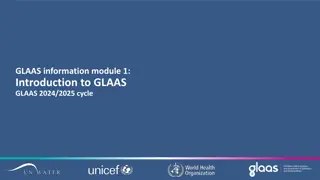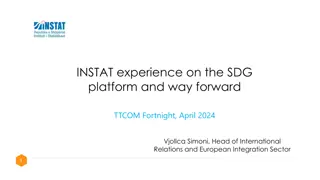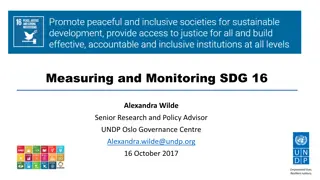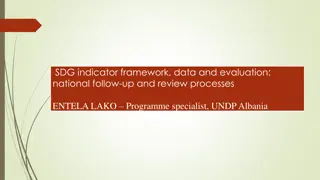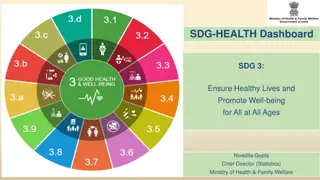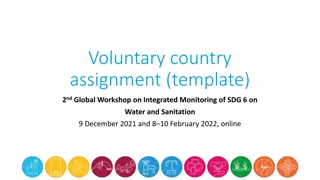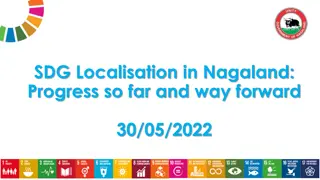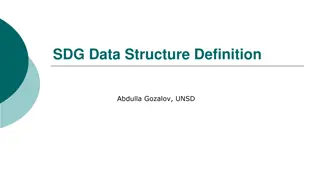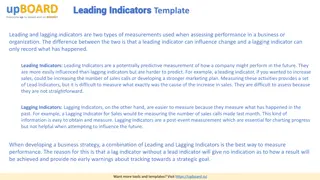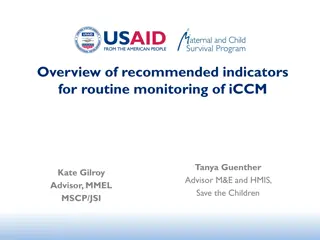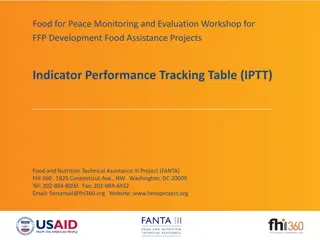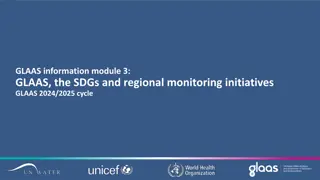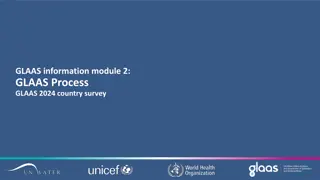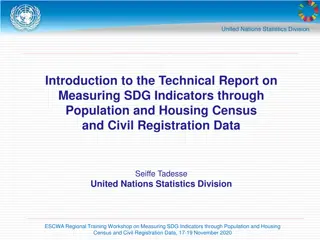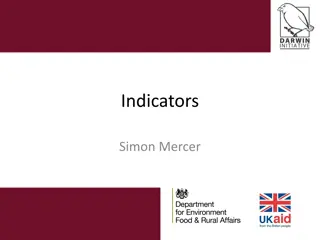Comprehensive Overview of GLAAS, SDG Monitoring, and Goal 6 Indicators
The content delves into the Global Analysis and Assessment of Sanitation and Drinking-Water (GLAAS), its relationship with the Sustainable Development Goals (SDGs), particularly Goal 6 on clean water and sanitation. It discusses regional monitoring initiatives, the 2030 Agenda for Sustainable Development, 17 goals, 169 targets, and 232 global indicators. Detailed information on Goal 6, its targets, and direct links to water, sanitation, and hygiene (WASH) are provided. Furthermore, it highlights the monitoring of SDG 6 global indicators and targets, custodian agencies, and the GLAAS country survey's role in monitoring. Various contributors and indicators for monitoring Goal 6 are also outlined, emphasizing cooperation, participation, and integrated water resource management. The content underscores the significance of GLAAS in complementing other SDG 6 monitoring initiatives and the utilization of the TrackFin methodology for WASH accounts development.
Download Presentation

Please find below an Image/Link to download the presentation.
The content on the website is provided AS IS for your information and personal use only. It may not be sold, licensed, or shared on other websites without obtaining consent from the author. Download presentation by click this link. If you encounter any issues during the download, it is possible that the publisher has removed the file from their server.
E N D
Presentation Transcript
GLAAS information module 3 GLAAS, the SDGs and regional monitoring initiatives GLAAS 2021/2022 country survey
The 2030 Agenda for Sustainable Development 17 goals 169 targets 232 global indicators
Goal 6: Clean water and sanitation 1 goal 8 targets 11 global indicators
Seven other targets with direct links to WASH 1.4 Access to basic services 3.8 UHC Tracer Interventions 3.9 Deaths from water pollution 4.a Basic WASH facilities in schools 11.1 Safe and affordable housing and basic services 11.5 Reduce deaths from water-related disasters 13.2 Climate-resilient planning
Monitoring SDG 6 global indicators and targets UN-Water coordinates the monitoring of the targets and indicators under SDG 6 Contributors include: UN-Water GLAAS WHO/UNICEF Joint Monitoring Program (JMP) Integrated Monitoring Initiative (IMI) with other UN agencies 6.1.1 JMP 6.1 Drinking water 6.2 6.6.1 6.6 Eco- systems UN-Water Sanitation and hygiene 6.2.1a 6.2.1b 6.a and 6.b Cooperation and participation 6.a.1 6.b.1 6.3 6.5 Waste- water and water quality Water manage- ment 6.5.2 6.3.1 6.4 Water use and scarcity 6.3.2 6.5.1 IMI GLAAS 6.4.2 6.4.1
11 indicators for monitoring Goal 6 Indicator Custodian agencies Indicator (brief title) 5 indicators monitored by WHO with co-custodians 6.1.1 WHO/UNICEF Safely managed drinking-water services 6.2.1a 6.2.1b Safely managed sanitation services Handwashing materials WHO/UNICEF 6.3.1 WHO, Habitat Safely treated wastewater 6.3.2 UNEP Ambient water quality in water bodies 6.4.1 FAO Level of water stress 6.4.2 FAO Change in water use-efficiency over time GLAAS 6.5.1 UNEP Degree of integrated water resource management implementation 6.5.2 UNECE, UNEP Transboundary basin areas with operational arrangements for cooperation contributes to monitoring 6.a and 6.b 6.6.1 UNEP Change in wetlands extent over time 6.a OECD, WHO Water and sanitation ODA as part of coordinated spending plans 6.b WHO, UNEP Participation of local communities in water and sanitation management
GLAAS and SDG monitoring The GLAAS country survey contributes to monitoring 6.a and 6.b. The GLAAS country survey covers elements of the enabling environment for SDG 6, such as national targets, provisions for vulnerable populations and finance, that contribute to countries making progress towards SDG 6. Participating in GLAAS complements other SDG 6 monitoring initiatives The development of WASH accounts using the TrackFin methodology will also contribute to monitoring 6.a.
Goal 6: Target 6.a on international cooperation Data sources GLAAS 2021/2022 country survey question D9 on how external funding is channeled OECD Data on Official Development Assistance through the Creditor Reporting System
Goal 6: Target 6.b on community and user participation Data sources GLAAS 2021/2022 country survey question A11 Includes questions on IWRM Revised question on percent of population with access to opportunities for participation UNEP IWRM survey collects complementary data on community participation OECD Complementary data collected through Water Governance Indicators
Collaboration with regional initiatives in Africa AMCOW: GLAAS continues to work closely with the African Ministers Council on Water (AMCOW). Africa Water Sector and Sanitation Monitoring and Reporting (WASSMO) indicators are aligned with GLAAS and WASH accounts. N Gor monitoring: The GLAAS 2021 country survey contributes to and aligns with monitoring of the N gor commitments, reducing the reporting burden on countries. AMCOW focal points can contribute to the GLAAS process at national level.
Collaboration with regional initiatives in Africa Contribution towards the Global Water Partnership (GWP) - Southern Africa's Water Investment Scorecard: GLAAS information will be used as a data source informing the Water Investment Scorecard. WHO is working in collaboration with UNICEF, SWA and AMCOW on WASH aspects of the scorecard. The overall objective of the AIP Water Investment Scorecard is to enhance accountability for results in mobilization of water investments in Africa and sustain political and leadership commitment at the Heads of State level for gender transformative and climate resilience water and sanitation investments for the achievement of SDG 6.
Collaboration with other regional initiatives Latin America: GLAAS findings are presented as evidence for LATINOSAN in Latin America. South Asia: GLAAS findings have been used as part of SACOSAN in South Asia. Europe: In Europe, GLAAS synergy with the Protocol on Water and Health supports setting baselines and identifying national targets.
Collaboration with SWA GLAAS is the evidence arm of SWA and provides data for the SWA results framework and helps inform SWA working groups including the systems and finance working group. Participating in GLAAS will help with preparatory work for SWA High Level Meetings.
WASH BATs Collaboration with WASH Bottleneck Analysis Tool UNICEF and WHO collaborate to ensure alignment between WASH BATs and GLAAS. WASH BATs and GLAAS are complementary and ultimately serve different purposes. If a country recently conducted a WASH BAT, the results can be used in the GLAAS country survey. If a country participates in GLAAS and recognizes the need to dive deeper into certain topics to develop an action plan, it could conduct a WASH BAT. GLAAS questions have been incorporated into the WASH BAT and GLAAS sections align with WASH BAT building blocks. Over 50 countries have conducted WASH BATs.
UNICEF and WHO Global Affordability Monitoring Initiative Goal: To develop a common vision and accepted methodology for monitoring WASH affordability globally for the SDG period and beyond. The report released by UNICEF and WHO in 2021 recognized the challenges in defining affordability and the need to strengthen data availability, quality and analysis on WASH tariffs, costs and expenditures in order to establish a better understanding of WASH affordability. The GLAAS country survey and data collected through the development of WASH accounts contributes to filling data gaps on monitoring WASH affordability.
Thank you! For additional information please contact glaas@who.int





